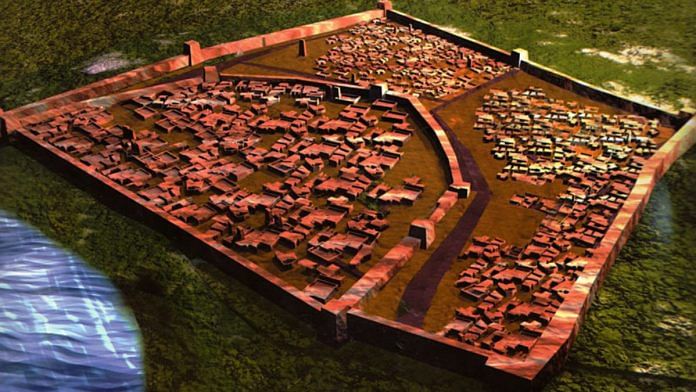The discovery of the Harappan Civilization over a century ago, which led to excavations at many sites by many generations of archaeologists, has given us a glimpse into the Indian subcontinent’s ancient civilisation. How the Harappans mastered the art of sustaining diverse ecologies, created a complex trade matrix and craft specialisation, among other things, are a few facets that were uncovered during these excavations. But more often than not, the conversations around these aspects of the civilisation don’t go beyond the Big Five—Mohenjo Daro, Harappa, Ganweriwala, Rakhigarhi and Dholavira. Rarely the names of smaller cities, towns, rural or craft centres are mentioned in the public forum. Banawali is one such site that is located between three major Harappan centres – Rajasthan’s Kalibangan in the west and Haryana’s Rakhigarhi in the east and Harappa in the north.
The site broke the conventional notion of town planning, telling us that not all Harappan sites had streets intersecting at 90⸰. Along with yielding the only physical example of a plough, the site had the earliest recorded use of the Amla, Shikakai and Reetha—the original detergent.
This is the story of the rise and fall of this Harappan city and its many unique features.
Also read: Fantastical beasts, sacred motifs—unique Harappan seals that drove Indus valley economy
The D-shaped city
Like many Harappan sites in the subcontinent, the urban characters of Banawali evolve from its preceding early farming cultures (Pre or Early Harappan period). Gradually, the markers of Harappan urbanism such as town planning, sophisticated art, craft specialisation and trade connections started to appear during Mature Harappan or Classical Harappan period around c.2600 BCE. And subsequently, the disappearance of these characters is marked in the Post Harappa period by c.1900 BCE.
At Banawali too, the excavations from 1974-77 have revealed a three-fold cultural sequence, in a total deposit of 10 metres:
- Pre-Indus (erstwhile known as Early Harappan)
- Indus (or Mature Harappan)
- Post Indus (or Late Harappan)
The three periods denote the rise of Banawali city from the ashes of early farming society and its subsequent fall as an urban centre. The people of the Pre-Indus period at Banawali lived in single-storey houses with thatched roofs made of mud and baked bricks, meticulously standardised, conforming to the ratio of 1:2:3.
Partially uncovered house complexes with several hearths, ovens and fire pits were found in the rooms, where excessive firing has caused the floor to redden. It was probably a workshop of a metalsmith. In another instance, a circular pit was lined with mud bricks and its walls were thickly plastered.
These features transitioned rapidly during the Indus or Mature Harappan period. The entire city was enclosed by a massive defence wall with bastions estimated to be around 275m x130m along the north-south and east-west axis. The walled city is then divided into the citadel and lower town. And both are fortified, each presenting unusual formations—an apsidal citadel and a trapezoidal town (lower town).
This unique town planning also affected the streets and lanes. The citadel had the usual arrangement of Harappan streets and lanes that ran straight along the cardinal directions, cutting each other at a straight angle. However, the trapezoidal lower town, exhibited ‘a nucleated radial layout’ of streets and lanes which in turn demarcated a series of acutely trapezoidal residential sectors.
Houses in Banawali were normally spacious with multiple rooms and a courtyard, at times connected by corridors. In one instance, a sitting room was paved with mud bricks. This house had a toilet with wash basins placed on a high place in a corner near the drains, which carried wastewater into the soakage jar. The famous Harappan seal with a horned tiger was found in this housing complex. Another house, which was bigger in size, yielded a large number of beads made of Lapis Lazuli, etched carnelian, gold and other artefacts such as weights. The findings led the excavator to label it as a jewellery dealer’s house. Some houses also had a square-shaped fireplace, similar to those found at Kalibangan.
Also read: Gujarat’s Khambhat has 5,000-yr-old history of bead-making. It wasn’t just limited to Viking Age
Clean and full of surprises
What’s more interesting is that at Banawali, an example of Harappan urbanism, the public drainage system was absent. Instead of drains, the people of the city would dispose of their household refuse by draining it into soakage jars placed at fixed points on the streets.
This meant that people were hygienic and maintained a protocol for keeping their city clean.
Besides these unique features of town planning, a large number of seals, sealings, and artefacts made of precious objects were found. Weights and measures found are important indicators of trade. The most significant finding however is the terracotta plough, which is the only specimen of what an ancient plough looked like.
Even a small town like Banawali is full of surprises. It was definitely a seat of authority and a strategically placed centre in the trade route that connected multiple metropolises and smaller/rural centres. Its layout and its unique findings suggest that at excavations, we might find things that are not typical textbook materials. It forces us to think out of the box and to keep looking for the unknown.
Disha Ahluwalia is an archaeologist and junior research fellow at the Indian Council Of Historical Research. She tweets @ahluwaliadisha. Views are personal.
(Edited by Ratan Priya)



